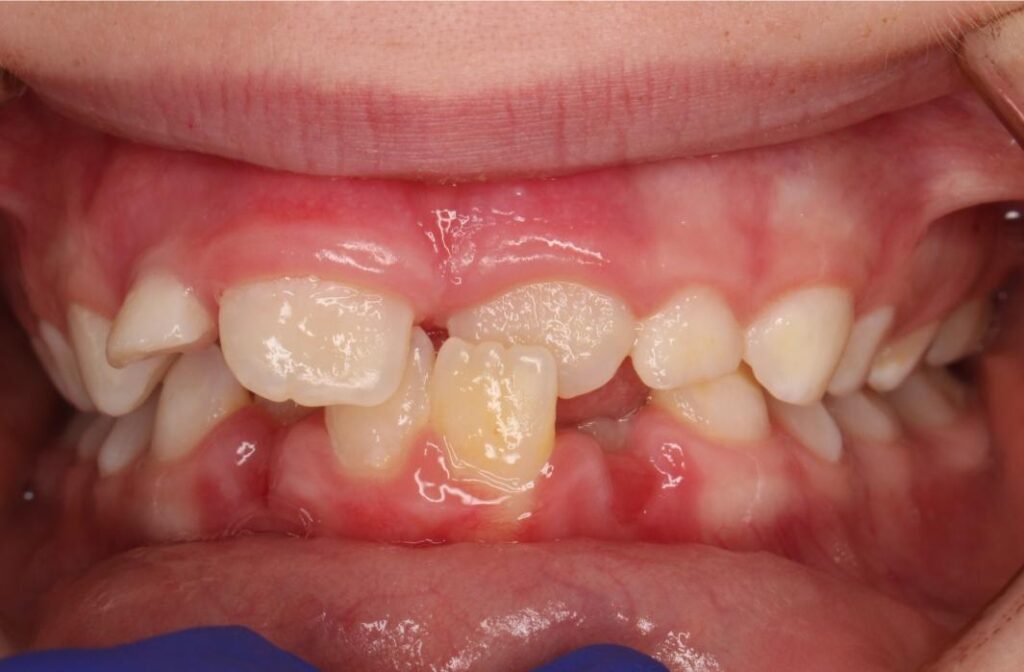Yes, braces can fix an underbite! Underbites may not be as common as overbites, but the results of orthodontic treatment by a board-certified orthodontist can be quite dramatic. Treatment options vary as individual factors such as age and jaw development as well as the severity of the underbite play an important role. Out here in Austin, Texas, Dr. Mathue Faulkner customizes his treatment of underbites with a variety of orthodontic techniques using braces, Invisalign, and additional appliances when needed. If you’re looking into treatment for an underbite, it is important to understand the nuances of these treatment options to decide on the best treatment plan for your bite. In this post, we delve into what an underbite is, the etiology of this orthodontic problem, when to see an orthodontist for an underbite, and how braces and Invisalign can help correct an underbite.
What is an Underbite?
Within the dental profession, an underbite is more commonly called an anterior crossbite. In a healthy bite, the upper teeth always sit on the outside of the lower teeth, much like a shoe lid sits nicely around a shoebox. A crossbite occurs when one or more of the upper teeth sit behind the lower teeth.
Crossbites can be divided into anterior crossbites or posterior crossbites. A posterior crossbite is when one or more of the upper teeth in the back of the mouth, like a molar, sits behind the lower back teeth. An anterior crossbite, or underbite, is when one or more of the upper front teeth sit behind the lower front teeth. According to a recent study, anterior crossbites can be found in between approximately 8-20% of the population.
In addition to underbites and crossbites, there are overbites, deep bites, open bites, and scissor bites. We won’t go into the details and differences between these types of bites, but the great news is that a board-certified orthodontist like Dr. Faulkner can fix these malocclusions with braces and Invisalign as well.


What Causes an Underbite?
Underbites occur for a variety of reasons, and often the etiology is multifactorial meaning there are multiple contributing factors:
1. Jaw size discrepancy: Often a hereditary trait, a mismatch between the size of the upper and lower jaws can result in an underbite. Underbites can occur because the upper jaw is undersized, the lower jaw is oversized, or a combination of both. Jaw size discrepancies like this often have a large genetic component, and it is not uncommon to see several members of the same family have an underbite due to a jaw size discrepancy. In fact, an example of the genetic component in underbites can be seen in the Habsburgs line, a German-Austrian royal family who were widely known for their underbites.
There are times when there is a jaw size discrepancy, but the upper teeth are flared and/or the lower teeth are tipped back enough that an anterior crossbite isn’t present. I like to refer to these situations as “hidden underbites.” The tricky issue with these bites is that patients don’t always realize they have a problem with their bite. It isn’t until after orthodontic treatment begins that the underbite will often present itself.
2. Missing teeth or severe crowding: Whether it’s due to genetics, decay, or trauma, missing teeth in the upper arch can often lead to an underbite. Since there are fewer upper teeth in this scenario, the teeth tend to collapse in and take up less space than in a normal bite. If severe enough, crowding can create the same issue. Additionally, crowding can cause teeth to erupt into irregular positions which may lead to an underbite.
3. Tongue thrust/posturing: Tongue habits can cause a variety of orthodontics issues including underbites. The tongue is a strong muscle, and through abnormal swallowing and posturing over time, that muscle is strong enough to push teeth into a position that may cause an underbite, overbite, or an openbite.
4. Trauma or injury: Trauma to the face or jaw can disrupt the natural alignment of teeth, potentially resulting in an underbite.
5. Skeletal disorders: Skeletal disorders can cause a variety of issues with overall jaw growth which may lead to an underbite.
Overall, the etiology of an underbite is often multifactorial, with a combination of genetic predisposition, environmental factors, and developmental influences playing a role in its development.
What is the Best Age to Fix an Underbite?
In general, early screening and intervention is recommended for any type of crossbite, including underbites. Many orthodontists prefer to see patients with anterior crossbites, or underbites, as young as 6 years old. Depending on the severity and etiology, the orthodontist may choose to monitor the underbite for several years. Unless the underbite is so severe that it is clearly a case that will require jaw surgery, most orthodontists will want to treat an underbite while the patient is still growing and orthodontic appliances can more effectively guide the development of the jaws. Even still, treatment can also be successful in adults. It’s best to consult with an orthodontist who can assess your specific situation and recommend the most appropriate treatment plan for you.


How Do You Fix an Underbite with Braces?
Depending on the underbite severity, the etiology, and the age of the patient, there are a variety of approaches that an orthodontist may use to correct an overbite:
1. Braces and elastics: Many underbites can be fixed with just traditional braces and rubber bands. The braces gradually move the teeth into proper alignment while the rubber bands help coordinate the top and bottom teeth into a more favorable position. In lieu of rubber bands, some orthodontists may opt to use CS5 springs or similar appliances if there is a concern that patients may not wear their rubber bands consistently. Regardless, this is a great solution for underbites that have a larger dental etiology than a skeletal etiology.
2. Reverse pull headgear: In order to influence jaw growth at a young age, many orthodontists prefer to use a facemask, or reverse pull headgear, as a method to help the upper jaw develop more fully. This type of treatment is typically performed with younger children, and the headgear is only worn at home and during sleep hours. The headgear is often used in conjunction with a palatal expander in order to maximize treatment results.
3. Tooth ramps: In young children with single-tooth crossbites, or underbites, a simple bite ramp can be used to correct the problem. A bite ramp is a small piece of dental composite that is temporarily bonded onto the lower tooth in a way that guides the upper tooth forward. Treatment time with this method often only takes a couple of months. At Rise + Smile Orthodontics in Austin, TX, our board-certified orthodontist has treated many cases with this quick and simple method.
4. Bollard miniplates: A relatively innovative treatment modality, bollard miniplates can be used in growing patients to assist in upper jaw development. Most of the miniplate is positioned underneath the gum tissue by a surgeon, but a small hook sticks out from the gums so that a patient can wear elastics. Miniplates are used in cases where there is a large skeletal component to the underbite, and patients are hoping to avoid orthognathic surgery (jaw surgery) or at least make the later surgery easier.
5. Extractions: While extractions are often not warranted, there are situations where the underbite is combined with enough crowding that an orthodontist may recommend extractions to correct both the crowding and underbite. Generally, extraction treatment will be in conjunction with braces and rubber bands.
6. Surgery: In more severe cases or when facial esthetics is a large concern, jaw surgery may be required in addition to traditional braces. Patients must be fully grown prior to jaw surgery, so the minimum age to even start this type of treatment is generally 18 years. While jaw surgery may seem daunting, results from this type of treatment are often the most dramatic.
The specific treatment plan for correcting an underbite will vary depending on factors such as the patient’s age, the severity of the underbite, and any accompanying dental or skeletal issues. An orthodontist will evaluate these factors and create a customized treatment plan tailored to the individual’s needs. Regular follow-up visits are important to monitor progress and make any necessary adjustments to the treatment plan.
Can Invisalign Fix an Underbite?
For mild to moderate underbites, Invisalign may be a viable treatment option. Similar to braces, many underbites can be corrected with Invisalign by using rubber bands to guide the upper and lower teeth into a proper relationship. Most often these rubber bands are attached to the Invisalign tray.
For more complex cases, Invisalign can also be used with extractions or even jaw surgery to correct an underbite.

Summary
While there are many reasons why someone may have an underbite, and there are varying degrees of severity, the good news is that it can be corrected by either braces or Invisalign in most cases. Early intervention is important, but even underbites in adults can be corrected.
If you’re local to Austin, TX, then please reach out to Rise + Smile Orthodontics to schedule your free consultation with Dr. Mathue Faulkner so that you can discuss the different options for your particular bite.
 (512) 892-1188Free Consult
(512) 892-1188Free Consult


